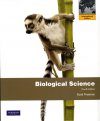![Biological Science (International Edition with MasteringBiology Access Card) Biological Science (International Edition with MasteringBiology Access Card)]()
Click to have a closer look
About this book
Contents
Biography
Related titles
Recommended titles
About this book
Building upon Scott Freeman's unique narrative style that incorporates the Socratic approach and draws you into thinking like a biologist, the Fourth Edition has been carefully refined to motivate and support a broader range of learners as they are introduced to new concepts and encouraged to develop and practice new skills. Each page of the book is designed in the spirit of active learning and instructional reinforcement, equipping novice learners with tools that help them advance in the course-from recognizing essential information in highlighted sections to demonstrating and applying their understanding of concepts in practice exercises that gradually build in difficulty.
New to Freeman's MasteringBiology online tutorial and assessment system are ten classic experiment tutorials and automatically-graded assignment options that are adapted directly from content and exercises in the book. Package Components: - Biological Science, Fourth Edition - MasteringBiologyr with Pearson eText Student Access Kit
Contents
1. Biology and the Tree of Life
I. THE MOLECULES OF LIFE
2. Water and Carbon: The Chemical Basis of Life
3. Protein Structure and Function
4. Nucleic Acids and the RNA World
5. An Introduction to Carbohydrates
6. Lipids, Membranes, and the First Cells
II. CELL STRUCTURE AND FUNCTION
7. Inside the Cell
8. Cell-Cell Interactions
9. Cellular Respiration and Fermentation
10. Photosynthesis
11. The Cell Cycle
III. GENE STRUCTURE AND EXPRESSION
12. Meiosis
13. Mendel and the Gene
14. DNA and the Gene: Synthesis and Repair
15. How Genes Work
16. Transcription, RNA Processing, and Translation
17. Control of Gene Expression in Bacteria
18. Control of Gene Expression in Eukaryotes
19. Analyzing and Engineering Genes
20. Genomics
IV. DEVELOPMENTAL BIOLOGY
21. Principles of Development
22. An Introduction to Animal Development
23. An Introduction to Plant Development
V. EVOLUTIONARY PROCESSES AND PATTERNS
24. Evolution by Natural Selection
25. Evolutionary Processes
26. Speciation
27. Phylogenies and the History of Life
VI. THE DIVERSIFICATION OF LIFE
28. Bacteria and Archaea
29. Protists
30. Green Algae and Land Plants
31. Fungi
32. An Introduction to Animals
33. Protostome Animals
34. Deuterostome Animals
35. Viruses
VII. HOW PLANTS WORK
36. Plant Form and Function
37. Water and Sugar Transport in Plants
38. Plant Nutrition
39. Plant Sensory Systems, Signals, and Responses
40. Plant Reproduction
VIII. HOW ANIMALS WORK
41. Animal Form and Function
42. Water and Electrolyte Balance in Animals
43. Animal Nutrition
44. Gas Exchange and Circulation
45. Electrical Signals in Animals
46. Animal Sensory Systems and Movement
47. Chemical Signals in Animals
48. Animal Reproduction
49. The Immune System in Animals
IX. ECOLOGY
50. An Introduction to Ecology
51. Behavioral Ecology
52. Population Ecology
53. Community Ecology
54. Ecosystems
55. Biodiversity and Conservation
Customer Reviews
Biography
Scott Freeman received his Ph.D. in Zoology from the University of Washington and was subsequently awarded an Alfred P. Sloan Postdoctoral Fellowship in Molecular Evolution at Princeton University. His current research focuses on the scholarship of teaching and learning and he recently published two papers on his work: (1) how active learning and peer teaching techniques increase student learning and improve performance in introductory biology (Freeman, S., E. O'Connor, J.W. Parks, M. Cunningham, D. Hurley, D. Haak, C. Dirks, and M.P. Wenderoth. 2007. Prescribed active learning increases performance in introductory biology. CBE-Life Sciences Education 6: 132-139.); and (2) how the levels of exam questions vary among introductory biology courses, standardized post-graduate entrance exams, and professional school courses (Zheng, A.Y., J.K. Lawhorn, T. Lumley, and S. Freeman. 2007. Applications of Bloom's Taxonomy Debunks the "MCAT Myth." Science 25 January 2008: 414-415).

























![The Nature and Properties of Soils [Global Edition]](http://mediacdn.nhbs.com/jackets/jackets_resizer_medium/22/229384.jpg?height=150&width=116)








